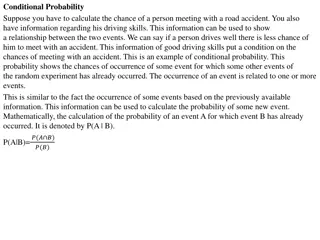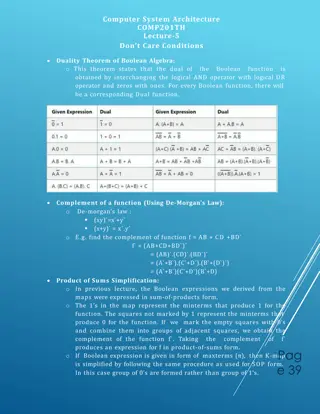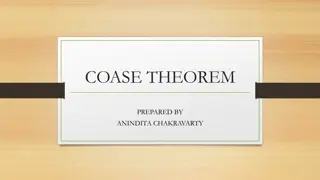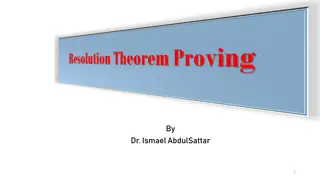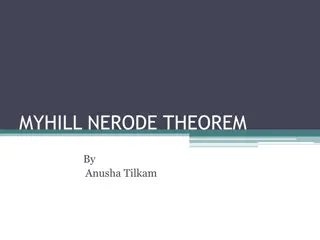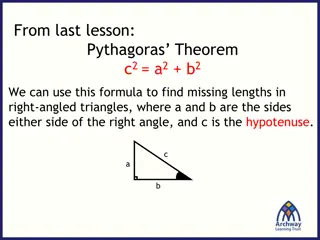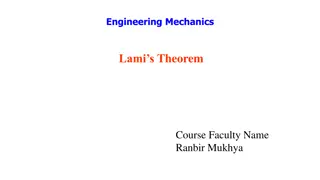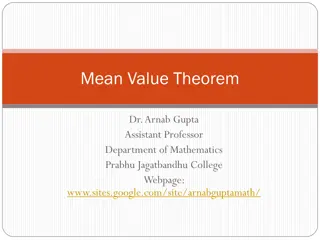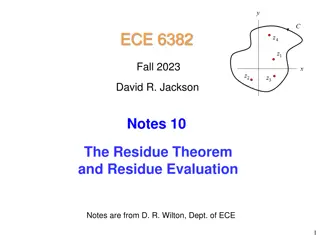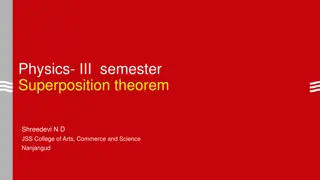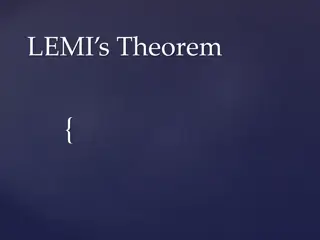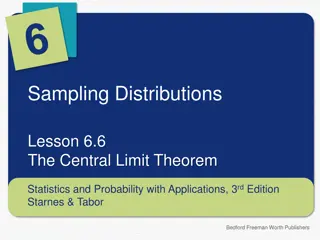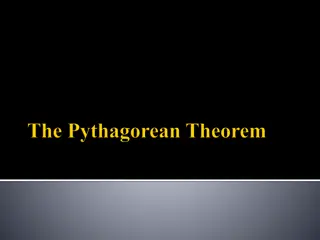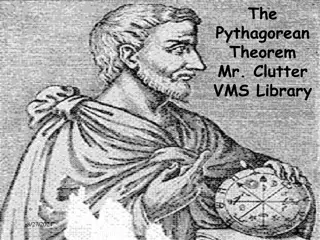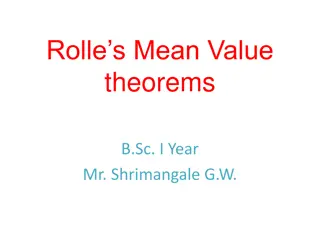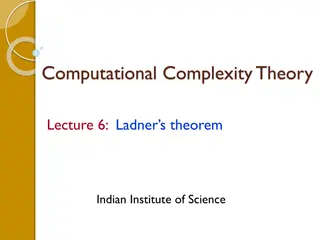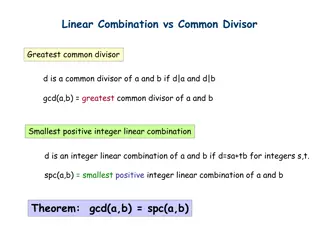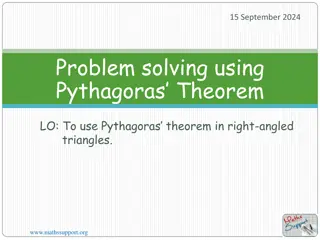Uniqueness Theorem for Determining Fields
The uniqueness theorem in electromagnetics discusses the necessary boundary conditions to uniquely determine fields, supporting concepts like image theory and the equivalence principle. It shows that if sources and tangential fields are specified, the fields inside a region are unique. The proof involves subtracting two field solutions, using source-free equations, the complex Poynting theorem, and examining terms on boundaries. From Maxwell's equations, it concludes that both the electric and magnetic fields on boundaries must be zero.
Download Presentation

Please find below an Image/Link to download the presentation.
The content on the website is provided AS IS for your information and personal use only. It may not be sold, licensed, or shared on other websites without obtaining consent from the author.If you encounter any issues during the download, it is possible that the publisher has removed the file from their server.
You are allowed to download the files provided on this website for personal or commercial use, subject to the condition that they are used lawfully. All files are the property of their respective owners.
The content on the website is provided AS IS for your information and personal use only. It may not be sold, licensed, or shared on other websites without obtaining consent from the author.
E N D
Presentation Transcript
ECE 6340 Intermediate EM Waves Fall 2016 Prof. David R. Jackson Dept. of ECE Notes 24 1
Uniqueness Theorem Shows what B.C. s are necessary to uniquely determine fields. Justifies image theory and the equivalence principle. Theorem Assume: (1) Sources (Ji , Mi) are specified in V. (2)Etor Ht is specified on S . (3) Region V is slightly lossy. S i i J M V Then (E , H) is unique inside V. It is allowed to specify Eton one part and Ht on the other part. 2
Uniqueness Theorem (cont.) Proof Assume different two solutions that have the same sources and tangential field (EtorHt) on S: (Ea, Ha) and (Eb,Hb) a a i = = E j H M b b i E j H M Subtract: ( ) ( ) a b a b = E E j H H 3
Uniqueness Theorem (cont.) Let a b E E E a b H H H Then ( ) ( ) = E j H Similarly (from Ampere's law), ( ) ( ) = H j E c Note that these are source-free equations. 4
Uniqueness Theorem (cont.) Now use the complex Poynting theorem: ( ) 1 2 E H ndS 1 4 1 4 2 2 + + 2 H E dV V ( ) 1 4 1 4 1 2 = 2 2 * * i i + E J + 2 j H E dV H M dV V V with E E H H i i i i = = 0 0 J J M M 5
Uniqueness Theorem (cont.) Hence, we have ( ) 1 2 ndS E H 1 4 1 4 2 2 + + 2 H E dV V 1 4 1 4 2 2 + = 2 0 j H E dV V Next, examine the first term. 6
Uniqueness Theorem (cont.) On S, ) ( = ) ( = * * n n ( ) ( ) 0 E H E H t t This follows since = t E = 0 H 0 on S. or t 7
Uniqueness Theorem (cont.) Hence 1 4 1 4 2 2 + + 2 H E dV V 1 4 1 4 2 2 + = 2 0 j H E dV V Set the real and imaginary parts to zero: 1 4 1 4 2 2 + = 0 H E dV V and 1 4 1 4 2 2 = 0 H E dV V 8
Uniqueness Theorem (cont.) Examine the real part: ( ) 2 2 + = 0 H E dV V Assume 0 0 V V in or in Then = = 0 0 E H V V in or in 9
Uniqueness Theorem (cont.) In either case, from Maxwell s equations we have that both must be zero: = = 0 in 0 in E H V V and Hence a b = = E E a b H H 10
Generalization Two regions with an interface: Et orHt is specified on S 1 1 1 Etand Ht continuous on The interface 2 2 2 Sources Note: If there are surface currents on the interface, then we require the appropriate boundary conditions on the interface to be satisfied. 11
Generalization (cont.) Note that Dnand Bn are automatically continuous at the boundary if the tangential fields are. z 1 1 2 2 = j D For example: H H 1 j H y y = x D z x 12
Example z Infinitesimal dipole: Il =1 + = 2 2 ( ) r A k A z z l y x Two possible solutions: + jkr jkr e e + = = A A z z 4 4 r r Both satisfy the Helmholtz equation for Az for the given source. 13
Example (cont.) We impose a B.C. at infinity for Et or Ht. Assumption: The correct solution goes to zero at infinity. z Il=1 V l y x S = S = 0 on t E S 14
Example (cont.) Both solutions tend to zero at infinity if there is no loss (we cannot tell which one is correct). The solution should now be unique. (The requirements of the uniqueness theorem are satisfied, which includes having a small amount of loss.) = , 0 k k jk k Assume We then have k r e + = 0 A z 4 r k r + e = as A r z 4 r jkr e + = A The correct choice is then z 4 r 15
Example Current source tangent to (and just outside) PEC body. i J = i 0 on E J S PEC t c Sc Surround Sc byS : = S S S c i J PEC Sc V S 16
Example (cont.) i J PEC Sc V S = = 0 on E S S S t c The sources inside V are specified (no sources in V ). Hence, (E,H) are unique inside V. ( ) ( , 0,0 E H = ) inside V This satisfies the source condition and the B.C.s, so it must be the correct solution. 17
Example (cont.) Conclusion: No fields i J PEC S An electric current tangent to a PEC body does not radiate. 18
Example (cont.) Similarly, we can examine a tangential magnetic current on a PMC body. No fields i M PMC S A magnetic current tangent to a PMC body does not radiate. 19
Sommerfeld Radiation Condition This is a more powerful boundary condition at infinitythat does not require the medium to be lossy. = , , , , , , . A A A E E E Let etc x y z x y z ( ) 2 + 2 = k S r Assume that Then is unique if: = (1) Lim r ( ) r 0 + = (2) Lim 0 r jk r r 20
Example Use jkr e + = = r jkr jkr 1 r 1 r e e + = + = jkr r jk r jk jk r e 2 r r r 1 r = jkr e 0 r as The function + satisfies the Sommerfeld radiation condition at infinity. 21
Example (cont.) Now use + jkr e = = r + + jkr jkr 1 r e e + = + + r jk r jk jk r r r 1 r + + = jkr jkr 2 jke e 0 r as The function - does not satisfy the Sommerfeld radiation condition at infinity. 22


